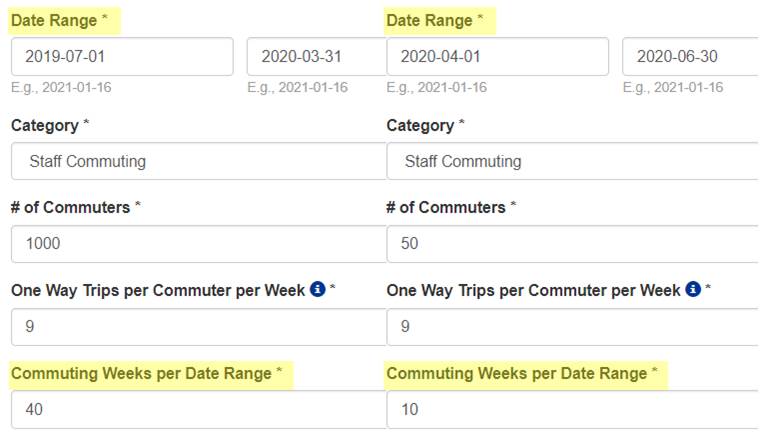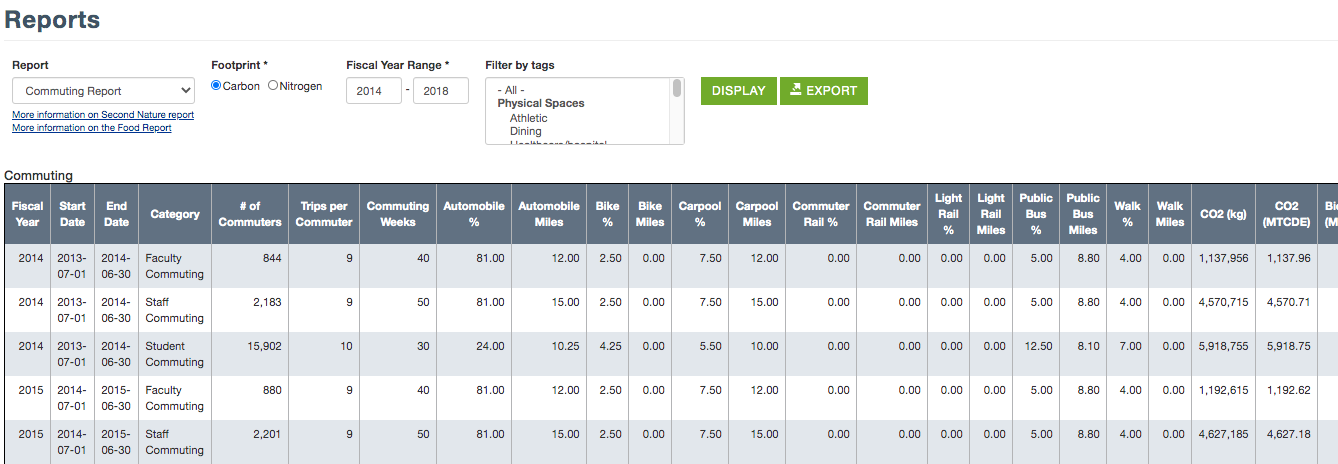Given the very different commuting patterns in 2020 due to Covid, we are providing guidance for commuting data entry and we have made updates to commuting data entry in SIMAP. As always, please contact us at simap@unh.edu with any specific questions. We also welcome any suggestions you have for improving commuting data entry in the future.

Entering your commuting data for 2020
Please use the following guidelines to enter your commuting data for 2020:
- Enter multiple entries as needed to reflect different commuting patterns in different time periods.
For example, you could have one data entry for student commuters for 7/1/19 - 3/31/20, and a separate data entry for student commuters for 4/1/20 - 6/30/20. This will allow you to reflect changes in commuting patterns if your campus shifted to remote learning during 2020.
- If entering multiple data points by commuter, be sure that the number of weeks is correct for that time period.
An accurate entry for the number of weeks is key because SIMAP uses that when calculating commuting emissions. Be sure that the number of weeks you enter reflects the weeks in the designated date range. For example, the calculation for student commuter automobile emissions is:
Student commuter automobile = # of commuters * one-way trips per commuter per week * commuting weeks per date range * % of trips by automobile * vehicle miles / trip * emissions factor

Note: This data is for demonstration purposes. Please make changes that are appropriate for your specific campus.
What about telecommuting?
We added telecommuting as a commuting option in 2022, and you can now account for hybrid and remote work in your commuting footprint. While telecommuting is not a direct travel mode like driving or carpooling, telecommuting does have a footprint. For example, telecommuting requires off-campus electricity and heating usage. Our research suggests that telecommuting requires 1 - 3 kWh per telecommuter per work day, which results in US average CO2 emissions of 100 to 350 kg CO2 per telecommuter per year. You can view the conversion factors for telecommuting (kWh/day) on the Scope 3 factors page. Updated 12/22/2025.
Updates to SIMAP to help make commuting data entry easier
We removed some of the restrictions on commuting data entry to make it easier to enter unique data sets. Specifically, we made the following two changes:
- It is now possible to enter multiple data entries by commuting type by date range (e.g., two entries for student commuters for a given time period)
- The commuting modes no longer need to total 100%
Additional tips for commuting data entry
Be sure to avoid double-counting emissions from commuters with your fleet vehicles. For example, many campuses run their own bus service, and the emissions from those buses would be reflected in scope 1 direct transportation. If this is the case for your campus, then be sure to remove public bus commuting by university-owned buses from your scope 3 commuting data entry to avoid double-counting those emissions.
The new commuting report, which can be found on the reports tab, provides all of your commuting information in one place. This can be helpful for reviewing your full commuting data set and tracking changes over time.
Partial screenshot of the commuting report:

Coming soon: More guidance and commuting dates from the Commuting Working Group
The Commuting Working Group, co-facilitated by Second Nature and SIMAP, has been working hard to develop recommendations and materials to help with accurate and easier commuting data collection and entry. Specifically, the commuting working group has been working on:
- A proposed survey that you can customize and use for your campus
- Updated data entry options to encourage more consistent and comparable reporting
- Guidance for calculating commuting electric vehicle emissions
Please note that your current commuting data entry will continue to be sufficient for calculating your commuting footprint! These updates aim to make commuting footprints more transparent and consistent. We hope to release this functionality later in 2021. Please contact us at simap@unh.edu with any questions.

